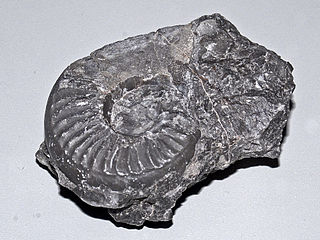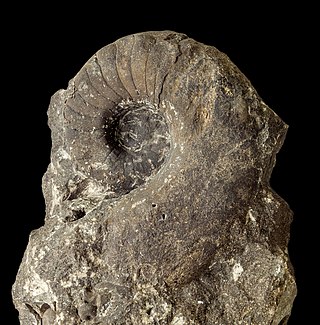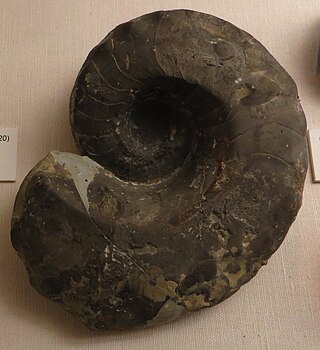
The Trigonoceratoidea are a superfamily within the Nautilida that ranged from the Devonian to the Triassic, thought to have contained the source for the Nautilaceae in which Nautilus is found.
Syringonautilidae is a family of Nautiloidea from the middle to late Triassic. Syringonautilidae comprise the last of the Trigonoceratoidea and are the source for the Nautilaceae which continued the Nautiloidea through the Mesozoic and into the Cenozoic right down to the recent. Syringonautilidae is a strictly Triassic family, derived early in the Triassic from the Grypoceratidae.

Grypoceratidae is the longest-lived family of the Trigonoceratoidea, or of the near equivalent Centroceratina; members of the Nautilida from the Upper Paleozoic and Triassic.
The Centroceratidae is the ancestral family of the Trigonoceratoidea and of the equivalent Centroceratina; extinct shelled cephalopods belonging to the order Nautilida
Tainonautilus is an extinct coiled cephalopod that lived during the Permian and Early Triassic which is included in the nautiloid family Tainoceratidae.
Aphelaeceras is an extinct genus from the nautilid family Trigonoceratidae which is part of the Trigonocerataceae, that lived during the Mississippian Period in the late Paleozoic.

Tainoceratidae is a family of late Paleozoic and Triassic nautiloids that are a part of the order Nautilida, characterized by large, generally evolute shells with quadrate to rectangular whorl sections. Shells may bear ribs or nodes, or both.
Thuringionautilus is a genus of large, moderately involute, nautiloids from the nautilid family Tainoceratidae. The whorl section is subquadrate, flanks slightly convex, venter broad with a median furrow. Ventral shoulders, narrowly rounded to subangular; umbilical shoulders, broadly rounded. Longitudinal nodes slope diagonally backwards on the venter toward the furrow. Suture, slightly sinuous. Siphuncle, subdorsal.

Metacoceras is a nautilitoid cephalopod from the Upper Carboniferous (Pennsylvanian) and Permian, the shell of which is moderately evolute with a subquadrate whorl section, bearing nodes on the ventral or umbilical shoulders or both, but otherwise smooth. The siphuncle is small, subcentral and orthochoanitic. The suture has shallow ventral and lateral lobes but no dorsal or annular lobe.
Holconautilus is a genus of nautiloids from the family Tainoceratidae and order Nautilida, named by Mojsisovics, 1902, and known from Upper Triassic sediments in Europe and E Indies (Timor). Its shell, evolute, discoidal, with simple coarse lateral ribbing; whorl section, subrectagular with a broadly arched venter.
Anoploceras is a genus of Middle and Upper Triassic nautiloids included in the Tainoceratidae, known from eastern Europe. The shell is evolute with only a slight overlap of previous whorls. Whorl section is subquadrate, like Pleuronautilus, only depressed. Flanks have conspicuous ribs that may be somewhat sinuous.
Encoiloceras is a genus of Tainoceratids, a nautiloid cephalopod in the order Nautilida that has been found in Upper Triassic (Carnian) sediments in the Alps and Hungary.
The Rhiphaeoceratidae are a small family of nautilids included in the superfamily Tainoceratoidea that comprises four very similar genera. These genera are characterized by a perforate umbilicus and little more than a single evolute coil. Whorl sections are oval, subquadrate, or subtrapezoidal. Sutures bend forward on the outer rim, forming wide shallow ventral saddles and dip strongly to the rear on the inner rim, forming deep dorsal lobes.
Subvestinautilus is a genus of evolute koninckioceratids, in the order Nautilida, with a depressed, trapezoidal whorl section. The venter is broadly rounded, ventrolateral shoulders sharply rounded, flanks flattened and converging toward a narrow rounded dorsum. In early growth stages a keel forms on the umbilical shoulder which becomes rounded or marked by a longitudinal rib at maturity. The suture has a broadly rounded ventral lobe and a deeper lateral lobe.
Pseudonautilidae is a family of Jurassic and Lower Cretaceous nautilid cephalopods belonging to the same superfamily as modern Nautilus, Nautilaceae, but forming a different branch from the family Nautilidae. Pseudonautilids, together with other nautilids, were contemporary with the ammonoids, which comprise an entirely different set of shelled cephalopod stocks more closely related to octopus and squid.
The Tetragonoceratidae is a small family of nautilitids constituting a part of the superfamily Tainocerataceae in which shells are coiled with a generally quadrate whorl section. Coiling is either gyroconic or evoluute with a slight dorsal impression. Flanks diverge from the umbilical to the ventral shoulders so as to make the whorl sections widest close to the venter. Nodes made develop on the flanks and shoulders. The siphuncle is tubular, typically found near the venter. Sutures are with lateral lobes and may possess dorsal and ventral lobes as well.
Nassauoceras is a tetragonoceratid nautiloid from the Middle Devonian of Europe, the shell of which is evolute with a wide, deep umbilicus, slight dorsal impression, low arched venter, rounded ventral shoulders, and flanks that converge dorsally so as to produce a subtrigonal whorl section. Nodes are present on the ventral shoulders. Sutures have shallow ventral and lateral lobes. The siphuncle is near the ventral margin.

Deltocymatoceras is an involute cymatoceratid (Nautilioidea-Nautilida) with broadly arched whorl sides, strongly convergent on a narrow venter that bears a slight, rounded, keel-like ridge, and with no distinct ventro-latera shoulders. Sides bear cymatoceratid ribs that bifurcate near the middle of the whorl sides, but do not cross the venter. The suture has a somewhat pointed ventral saddle, broad lateral lobes and prominent saddles on the umbilical shoulders. The position of the siphuncle in undetermined.
Grypoceras is a coiled nautiloid cephalopod from the Triassic of western North America, southern Asia, and Europe that belongs to the nautilid family Grypoceratidae. Named by Alpheus Hyatt in 1883, the shell of Grypoceras is essentially involute with a subtriangular cross section, widest across the umbilical shoulders, with flanks fairing toward a narrow flattened venter. Sutures on flanks are with smooth, deep lobes and with shallow ventral lobes.

Germanonautilus is a cephalopod genus included in the nautilid family Tainoceratidae, found widespread in the Triassic of North America, Europe, Asia, and north Africa. The shell is a moderately involute nautilicone ; whorl section subquadrate to trapezoidal, widest across the umbilical shoulders, flanks flattened and ventrally convergent, venter flat and wide, dorsum narrowly and deeply impressed. The suture is with broad and deep lateral lobes and a shallow ventral lobe. The siphuncle is central and nummuloidal, composed of expanded segments that give a beaded appearance.




